Common Name(s): Purpleheart, amaranth, roxinho, violeta
Scientific Name: Peltogyne spp.
Distribution: Central and South America (from Mexico down to southern Brazil)
Tree Size: 100-170 ft (30-50 m) tall,
3-5 ft (1-1.5 m) trunk diameter
Average Dried Weight: 56.4 lbs/ft3 (905 kg/m3)
Specific Gravity (Basic, 12% MC): 0.76, 0.9
Janka Hardness: 2,520 lbf (11,190 N)
Modulus of Rupture: 22,000 lbf/in2 (151.7 MPa)
Elastic Modulus: 2,937,000 lbf/in2 (20.26 GPa)
Crushing Strength: 12,140 lbf/in2 (83.7 MPa)
Shrinkage: Radial: 3.8%, Tangential: 6.4%,
Volumetric: 10.6%, T/R Ratio: 1.7
Color/Appearance: When freshly cut the heartwood of purpleheart can be a dull grayish/purplish brown. Upon exposure—usually within a few days—the wood becomes a deeper eggplant purple. With further age and exposure to UV light, the wood becomes a dark brown with a hint of purple. This color-shift can be slowed and minimized by using a UV inhibiting finish on the wood. For more information, see the article Preventing Color Changes in Exotic Woods.
Grain/Texture: The grain is usually straight, but can also be wavy or irregular. Has a medium texture with good natural luster.
Rot Resistance: Purpleheart is rated as being very durable, and resists both decay and most insect attacks, though it has been reported to be susceptible to attack from marine borers.
Workability: Working with purpleheart can present some unique challenges: if the wood is heated with dull tools, or if cutter speeds are too high, purpleheart will exude a gummy resin that can clog tools and complicate the machining process. Depending on the grain orientation, can be difficult to plane without tearout. Purpleheart also has a moderate dulling effect on cutters.
Odor: Varies depending upon the species: most species have no characteristic odor, though some species can have a pungent scent.
Allergies/Toxicity: Although severe reactions are quite uncommon, purpleheart has been reported as a sensitizer. Usually most common reactions simply include eye and skin irritation, as well as nausea. See the articles Wood Allergies and Toxicity and Wood Dust Safety for more information.
Pricing/Availability: Widely available as lumber in good widths and thicknesses. Prices are in the low to medium range for an imported hardwood.
Sustainability: This wood species is not listed in the CITES Appendices. However, since purpleheart is a grouping of many species, its unclear if any given lumber is on the IUCN Red List of Threatened Species. Some of the more commonly harvested Peltogyne species, such as P. mexicana, P. paniculata, and P. venosa are not listed on the Red List. Many other species are listed as being of least concern. However, two species, P. chrysopis and P. gracilipes are both listed as endangered due to a small (less than 500 km2) and fragmented area of occupancy.
Common Uses: Inlays/accent pieces, flooring, furniture, boatbuilding, heavy construction, and a variety of specialty wood items.
Comments: Sometimes called amaranth, this colorful Latin American hardwood is tremendously popular for furniture and other designs that call for a unique splash of color.
In addition to its coloration, purpleheart has excellent strength and weathering properties, and can be used in applications where strength or durability is important—a wood with both form and function.
Images: Drag the slider up/down to toggle between raw and finished wood. The second set of pictures shows the short-term color shift that happens when the wood is freshly sanded and after three weeks’ time.
A special thanks to Steve Earis for providing the photo of the finished bowl of this wood species.
Identification: See the article on Hardwood Anatomy for definitions of endgrain features.
Porosity: diffuse porous; growth rings may be either distinct (due to marginal parenchyma) or indistinct depending on species and growing conditions
Arrangement: solitary and radial multiples
Vessels: medium to large, few; purplish deposits common
Parenchyma: winged, lozenge, confluent, unilateral, and occasionally banded (marginal)
Rays: medium width (barely visible without lens); normal spacing
Lookalikes/Substitutes: Its uniquely purple color isn’t commonly confused with anything else. Pieces with dulled or brown color can be confused with many other diffuse porous tropical hardwoods. However, Peltogyne species usually have unilateral parenchyma surrounding only one side of the pore—a feature not commonly seen on most other woods.
Notes: Heartwood fluoresces under blacklight
Related Content:

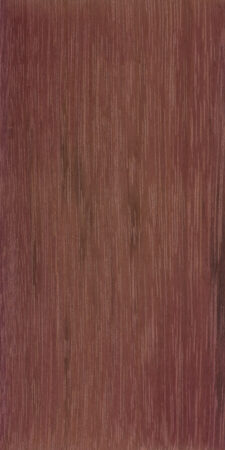

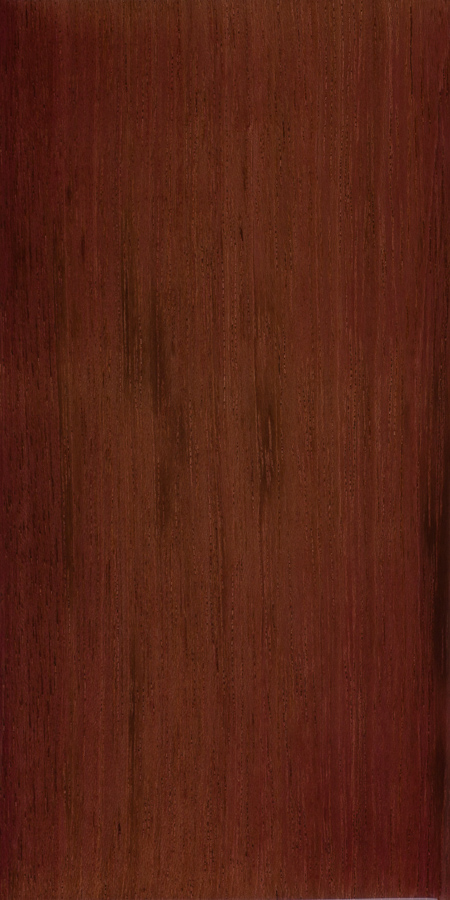
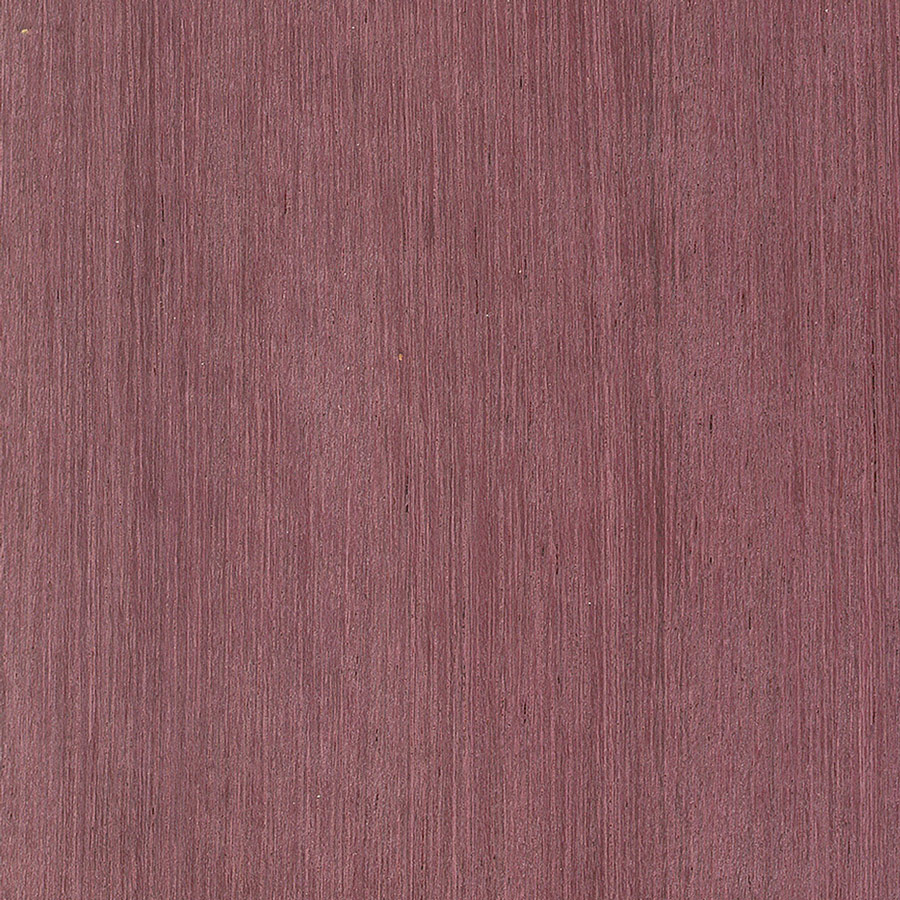
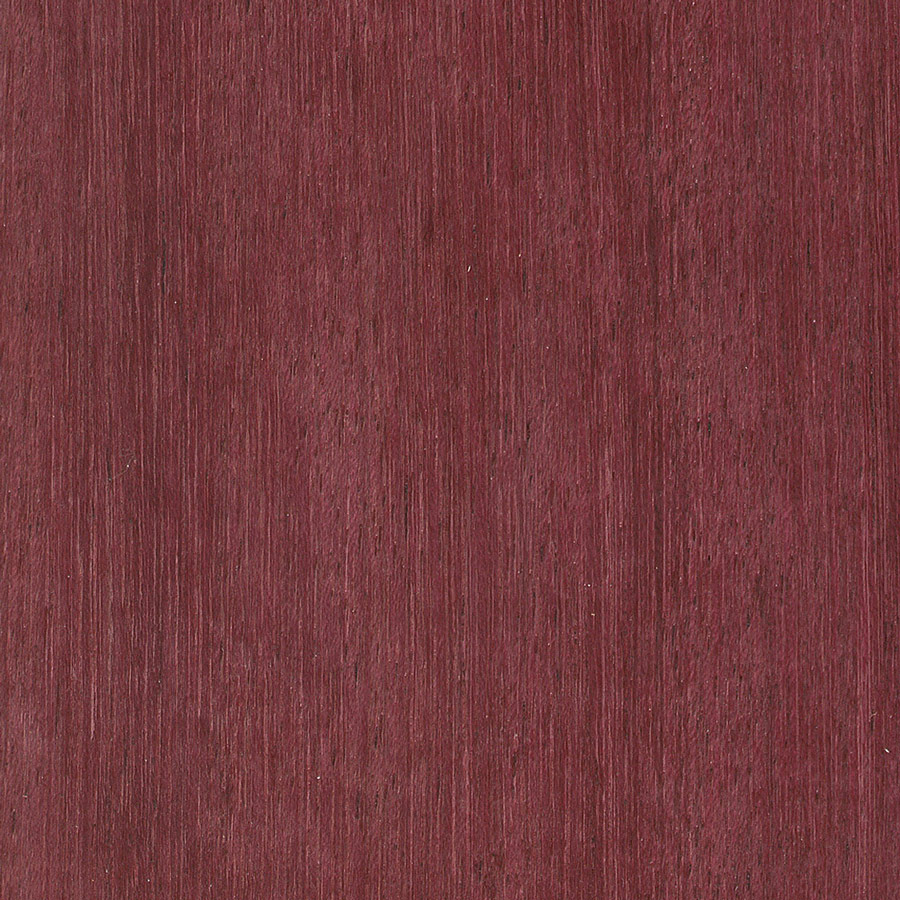
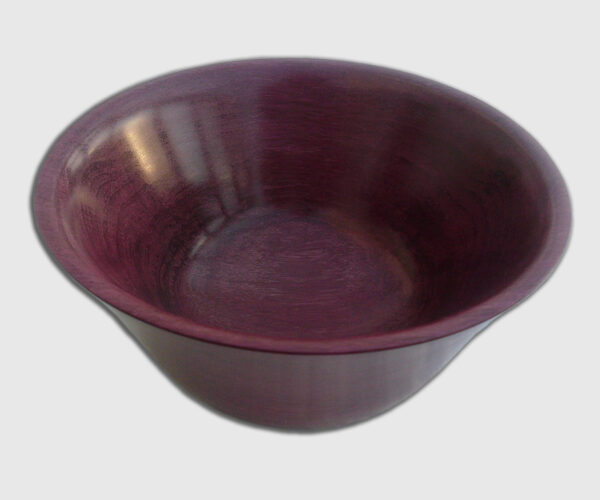
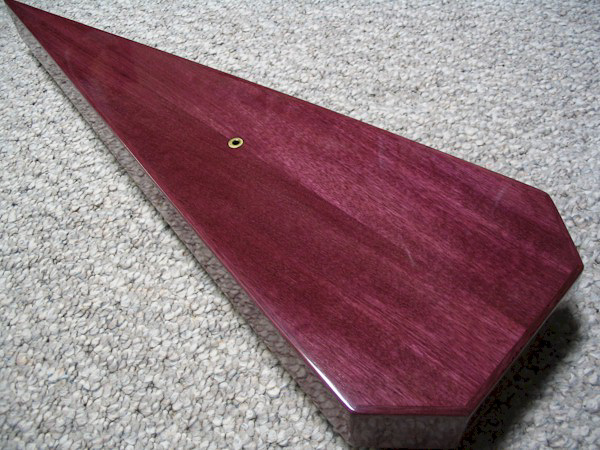





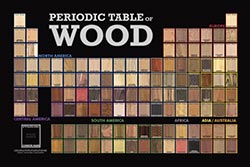
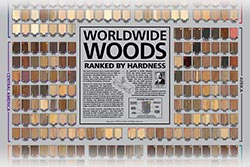



Made my wife a stemmed goblet with a purpleheart cup for her birthday this year. This wood was very nice to work with on my lathe. The goblet stem consisted of 9 square 1/2″ by 1/2″ by 8″ pieces of walnut and poplar. The waterproof glue I used had a small amount of “charcoal” non-sanded grout added to make it black in color. Attached is also a photo of the original 8″ long glued wood I started with, which pretty much shows how to make this type of goblet.
I’ve been woodturning for years, I’ve turned a couple pieces of purple heart and never got the purple quality color of wood. Found out using a torch or a heat gun brings out the perfect color. So exciting, I can’t wait for more projects to come
Knife handle made oh purple heart
Can purple heart be boiled to shape into rings and keep that purple color verses the grey color.
had some offcuts from making some purpleheart furniture so used the along with many other species in some speakers
I like the way it works for inlays
Pen from Purpleheart
Purpleheart is always nice to work with. A very hard and ding resistant wood. Carves nice with a rotary carver. Use a sharp double cut carbide burr to avoid burning the wood since the high oil content can make it turn black with too much heat. Nice smell and polishes very well. Unfortunately it will turn a plum color over time due to oxidation and all you can due is slow that process down. I use simple lemon oil as a finish in my carvings. The carving shown is about 20 years old and has been that color for most… Read more »
If sealed with a wipe on varnish is purpleheart safe to be used in making toys for my grand daughter? My grand daughter is 4 years old and does not have a problem with chewing on toys.
saw dust is the only aspect the presents a health risk. you should be fine!
I have some pieces of Purpleheart that react extremely different under UV light.
Can you woodburn purpleheart
Yes, I found that it actually takes a woodburn quite nicely.
Is Purple Heart a safe wood for Pets/Animals? Most namely, Rabbits.
Considering using it for some Creature Comforts I make.
@ Frank. NO
My favorite wood… I use it sparingly due to price. But use every scrap!
Beautiful work!
Nicolas described this work as beautiful. It certainly is!?
I saw some guitars by a German vendor, which used to have Rosewood fretboards until they replaced it by what they call ‘Amaranth’ some time ago, which translates into Purpleheart as I learned. However, nevertheless these are decent guitars they are quite cheap, too. The color of the Amaranth fretboard is by no means purplish, however.
So my question would be, is there another wood or wood-like material which is also called ‘Amaranth’ and used for the purpose I described above?
Thanks and best regards,
Jens
I haven’t worked with it (yet, though I have a piece set aside), but purpleheart apparently isn’t very colorfast. If you look at the pictures at the end of the article, the color fades after sanding/tooling, and then comes back–and then fades again over time (which is why I keep looking up what people do to maintain it).
My guess is that the fretboards are actual purpleheart/amaranth that faded from a combination of being cut and aged.
All I know is the wood has to be sealed to protect from the UV light.
The wood regains its color pretty quickly after being cut/sanded, but will begin to loose its color with constant exposure to UV light, so yeah, any kind of sealant that is stated to be UV repellent will help it maintain its color.
Obviously you refer to HB guitars. I’m pretty sure the fretboards are stained with a colored sealant. Time will tell will they go purple.
I just found this site, and love the information it has. I never knew about the problems with gluing purpleheart wood. I made a lamp using Purpleheart and Maple layers. I used Titebond II (or maybe II). It turned out beautifully. Do I need to worry about it coming unglued, in the future?
I sure hope I have not made the wrong choice for wood. I’m making cutting boards and want to use Purple Heart as an accent. Any problem health wise if I use it? In put please!
South American wood! Proud of our green and rich soils.
I have really enjoyed working with Purpleheart. Patience and care are required in machining due to it’s hardness. I glues and sands beautifully, and can be polished to a shine with finer and finer grit paper. I have been turning drumsticks from it that are better than hickory for durability and rebound due to the superior hardness, rupture resistance, and stiffness. This is easy to find, and not terribly expensive for smaller projects.
I’d love to see a photo of those drumsticks! Do you find that the tips are any more durable as well?
Of the woods I have used for drumsticks, sapwood Hickory, and Purple heart are my favorites, and hold up equally well. with good toughness and lively rebound.
Does purpleheart produce any seed or fruit?
Hi Nathan.
Yes, Purpleheart is a legume, which produces pods with single seeds inside. It also, as a legume, fixes nitrogen in the soil with it’s roots, improving soil fertility.
https://www.fpl.fs.fed.us/documnts/TechSheets/Chudnoff/TropAmerican/html_files/peltog1new.html
Hello, I am getting into the wood working scene, to start myself out I am making Pottermore wands to learn the basics on the Lathe and added detailing will be done via dremmel and hand etching. I have a big question on Purpleheart (Funny there is a wood named the same as the military honor for being wounded in the line of duty. A fitting name for such a lovely wood.) well make that two questions though the first is bigger than the second. First up, I want to make a special wand prop for my Stepsister, the reason it’s… Read more »
purple heart is the best wood GOD placed on earth,,,may he full my home with plenty of it
Purple hart pen I made.
Have a question. I bought this red/purple wood plank some 30-40 years ago and just used it as a trim on the enclosed table top. I just cannot remember what this wood is.
Is it bubinga? Is it purple heart? Can you help me?
(Top is cedar –or maybe juniper, finished with 3 coats Minwax Polyurethane.)
That looks like purpleheart to me.
Thoughts as to whether this would be feasible to make a kazoo and whether there are thoughts on what sealant would be best to maintain colour if so – I’m guessing beeswax wouldnt provide much resistance to preventing colour change?
Thanks, George
I have used Purple Heart many times and it is a beautiful wood however I do not recommend using a router on it because it has a great chance of tearing out. It is just one of those types of wood that has plenty of beauty but can be hard to work with.
Just wondering I’m making cutting boards and want to use Purple Heart as an accent. Any problem health wise if I use it?
None that I’m aware of. I have used it several times in cutting boards. Just make sure to clean any edges you’re going to glue up with acetone to remove any surface oils. I attached one of my latest projects. Also, be sure to add a coat of food safe finish to it. Butcher block oil from Lowes is good and normally what I use.
Unfinished work in progress. Here you can see the Purple Heart has lost quite a bit of color from all the sanding. I will leave halogen lights on it overnight and the color will return and then I will Lacquer it. https://www.westernrevival.net
Purple Heart and Hickory Name Plate. Gloss Lacquer finish
A company located in Brazil https://www.madeireirauliana.com has production with this lumber to Caribbean. A picture of slab doors made with Purpleheart, It´s a really exotic wood, stable , very , very hard and density ! One door constructed of Purpleheart, it will be impossible to be broken up, a very strong wood.
Beautiful doors.
I had some barn-board remnants that due to weight I thought were oak. After planning I was stunned to discover they were purpleheart (didn’t know that wood even existed). No idea how a barn constructed of this materials existed over 100 years ago in Wisconsin. I made a hallway/couch table out of it – 5.5 ft by 14 inches x 36 inch high. I used General finishes water-based poly with UV protection:
I made a strat body out of purpleheart. The board I found was the only one big enough for a one piece body. It was kind of brown, not very purple. When I had finished sanding it, the sun broke through just then, into the basement where I was working. I took the body over to see it in the sunlight. It started turning into a beautiful purple from the light. I ran out side to expose it to the sun, and the whole body turned purple in seconds.
I have been making kitchen cabinets with it on our kitchen remodel. This has been my first attempt at cabinets, made a few mistakes on the face frame but where fixable, just finished 4 of the doors and they have turned out beautiful. I couldn’t find a match for the inserts so we decided to go for a smoked glass. I have been trying to figure out how to make my drawer fronts and know they will have to be out of solid wood with routering detail. I have gone with a mitre instead of the shaker style. Could someone… Read more »
purpleheart guitar neck (raw, unsealed), body is made of limba
Beautiful! I have a Telecaster built with purpleheart. I love it!
Pushing 2 inlayed control knobs down onto potentiometer shafts is not a “telecaster built with purpleheart”……..
I’m sorry I failed to specify for the dumbasses, the top cap on the body is purpleheart and the neck is solid purpleheart. Matt Culler, you can bite my fucking ass!
Found a local guy , Don Mitchell, BC Canada at a farmers market, My wife saw a beautiful jewelry box he had made it was the first time we had ever seen this wood, the box is exquisite. He made it out of 4-5 different tropical woods but the Purple Heart made it a very beautiful anniversary gift.
You do know that there’s a little picture icon in the corner of the comments section where you can actually post pictures of the stuff you’re describing with your comment, right? Just sayin’… :)
Draconacae Draconus Acerphyla. The Maple-Leaf Dragon. I made a few
boxes with dragons on them. One of my classmates from high school
wanted one. He said “you choose the wood, you choose the dragon” So
this is what came out. Hope you like it!
That is unreal , how large is it, Cost, E mail @tobiassmit@hotmail.com.
Although severe reactions are quite uncommon, Purpleheart has been reported as a sensitizer. Usually most common reactions simply include eye and skin irritation. Purpleheart has also been reported to cause nausea. See the articles Wood Allergies and Toxicity and Wood Dust Safety for more information.
Paired with live edge Western Maple
Made a ring for my wife for mother’s day. this was my first attempt at
working with purpleheart. definitely a specialty thing I wouldn’t want
to mass produce, but I loved making it by hand
I’m thinking of doing the same thing. Did you make your own veneer slices? Was curious if it gums up trying to make thin slices. Also was wondering if glues well? Your input would be very appreciated.
An excellent wood for small finishes. GWR found long, 2mm thick strips
of purpleheart in a skip, apparently as packing for another hardwood to
be used for decking. For drawer faces it is superb.
I just purchased a ring with Purple Heart Wood “stone.” I have already put my hands in water more than once, forgetting I was wearing Wood. Probably a very bad idea. What suggestions do you have for how to best protect the Wood? Occasionally rubbing it with some kind of oil?
https://www.wood-database.com/wood-articles/wood-allergies-and-toxicity/ check out this page and look up “Purple Heart” I would say you could get some nasty splinters from this. as for decking i do not know for sure. Short answer: NO!! My answer would be from my experience in handling it for inlays. The wood is VERY hard and BRITTLE. fastener holes should be pre-drilled for screws or nails and the fastener should slide through easily. Countersink as well. screws should not be torqued very high as the screw head will create lateral force and split the wood. Keep screws at least 1.5 to 2 inches away from… Read more »
Hi, is this timber any good for decking? Does it leech, splinter or feather? Thanks
I just redid my deck with purple heart and it looks amazing. I used an edge fastening system so there weren’t any screw heads on the face of the boards. It was a lot of work but worth it for a 13’x40’ deck. The lumber cost me around 6k for everything.
Draconacae Draconus Acerphyla. The Maple-Leaf Dragon. I made a few boxes with dragons on them. One of my classmates from high school wanted one. He said “you choose the wood, you choose the dragon” So this is what came out. Hope you like it!
Paired with live edge Western Maple
Made a ring for my wife for mother’s day. this was my first attempt at working with purpleheart. definitely a specialty thing I wouldn’t want to mass produce, but I loved making it by hand
Steve how long would it take a (3/4″X3/4″X5″)piece of purpleheart to turn to a dark rich purple?
I have been making Intarsia for 17 or 18 years and it is a great wood, especially if you are making something to do with grapes, and since I use a band saw with 1/8th” blade, it cuts quite easily for me.
Does anyone have suggestions for the best types of tools to use while working with purpleheart? I am trying to split a 7 inch piece into a 3 inch piece.
Long live Purpleheart!
I do chip carving (art/designs on wooden products). My daughter gave me a purple heart board to work with. Though the wood is extremely pretty, it is one of the most difficult to work with. At times when working (cutting into the work) with my chip carving knife it sounds like cutting into metal. My actual times to complete a project expanded from 3 to 4 times the effort compared to the same project on Bass Wood or Tupelo. I have other wood carver friends that refuse to work with Purple Heart because of the extra effort involved. I personally… Read more »
An excellent wood for small finishes. GWR found long, 2mm thick strips of purpleheart in a skip, apparently as packing for another hardwood to be used for decking. For drawer faces it is superb.